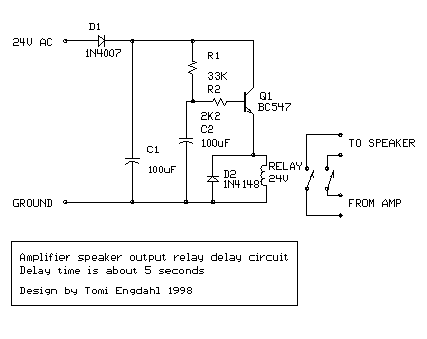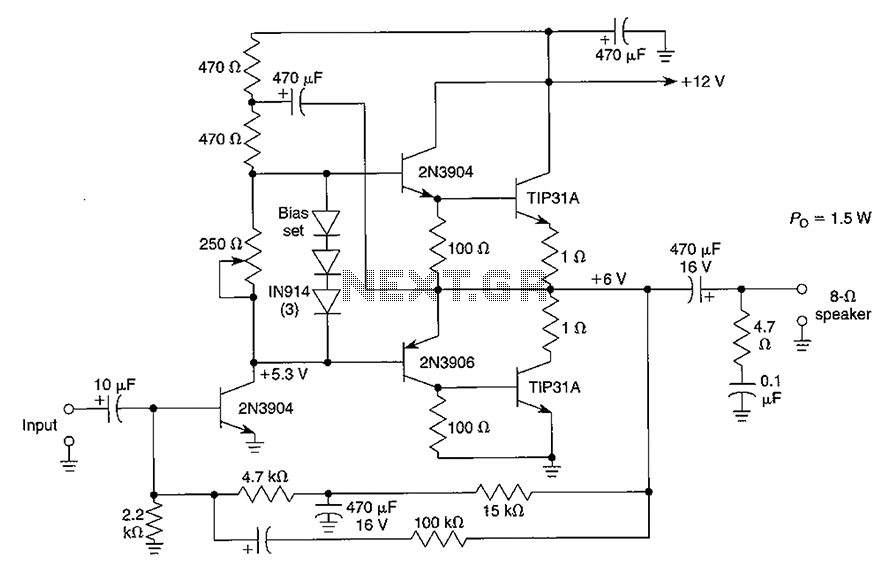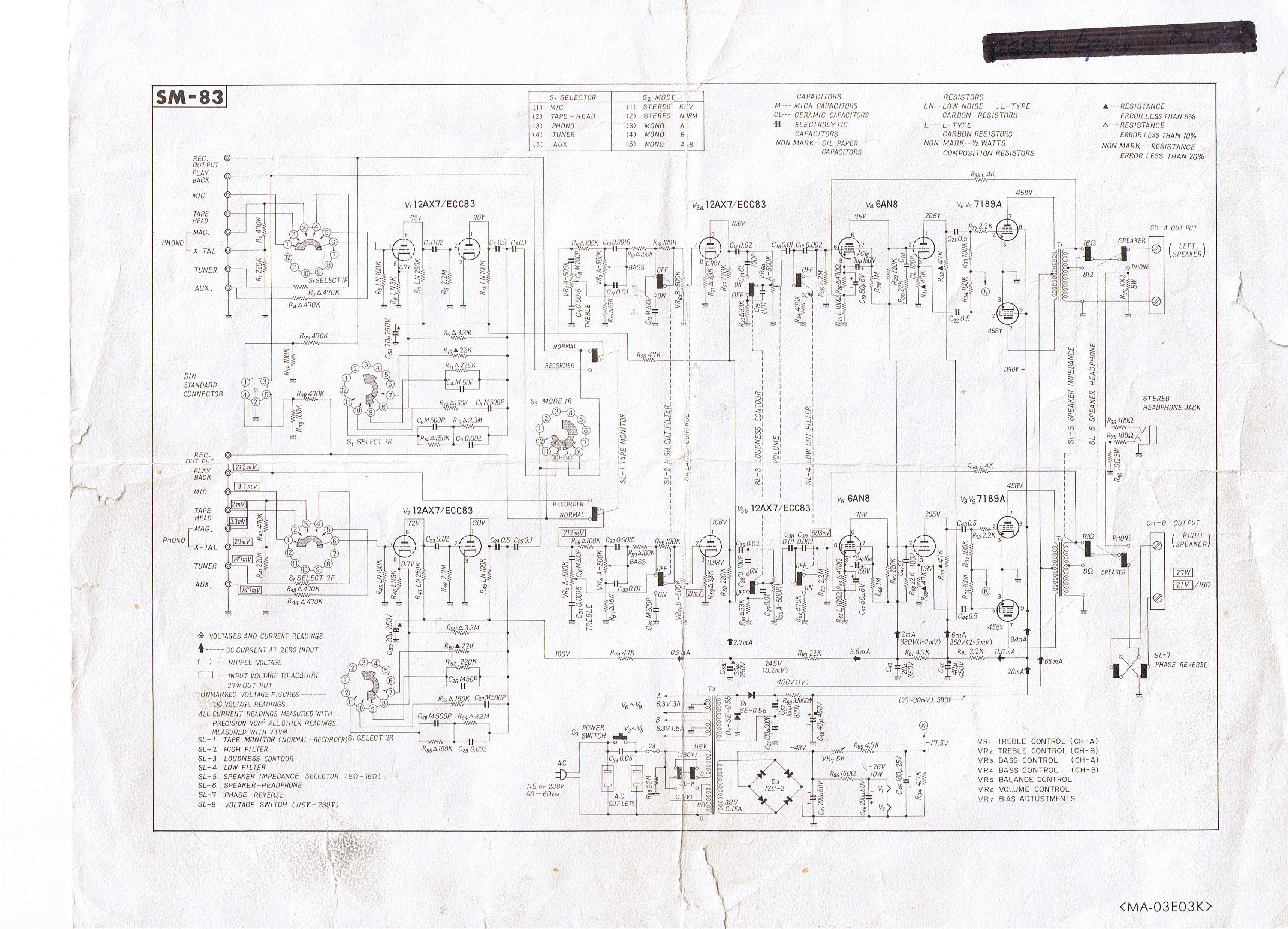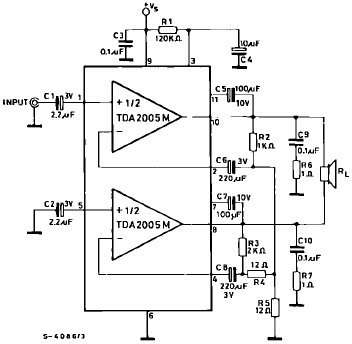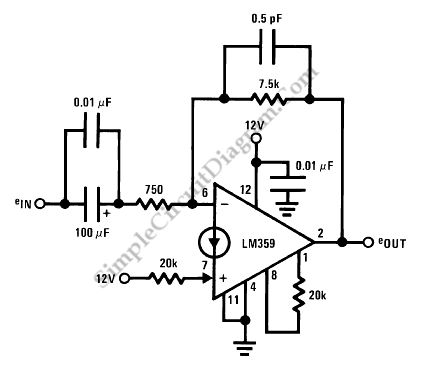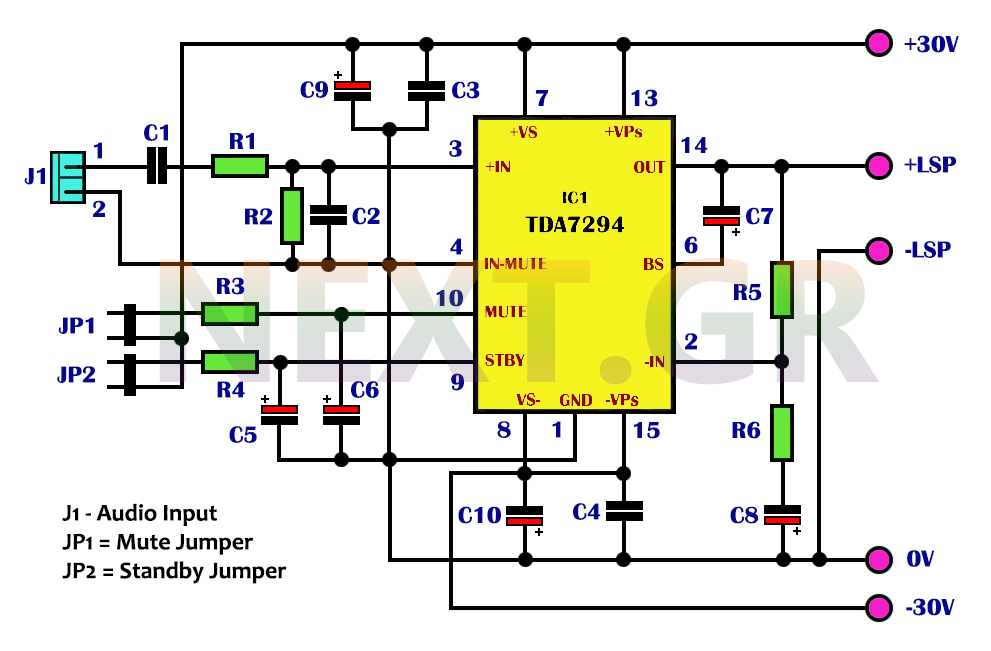
Spunky Tube Amplifier
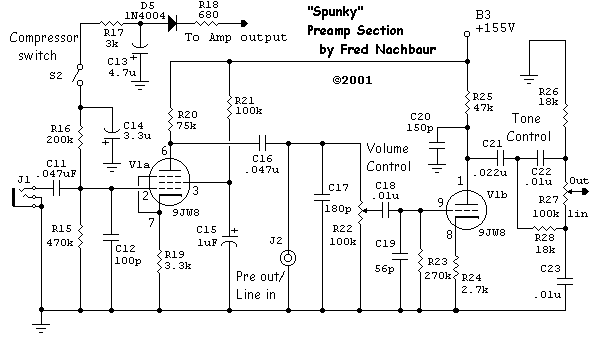
The diagram below illustrates that power supplies need not be complex, particularly in low-power applications. The filaments are powered directly from the 120-volt AC line, minimizing the size of the transformer(s) required to drive the amplifier. Note the slightly unusual series-parallel arrangement; each pair of 35C5 output tube filaments is in series with one half of the 12AU7 dual triode. The center-tap of the 12AU7 sums the two branch currents (150 mA each) into the preamp tube, yielding 300 mA as required for this valve's heater supply. While unconventional, this configuration is stable and safe. If any tube is removed (or its filament burns out), the others will not be affected, unlike some series-wired television sets where a single burnout could disable multiple tubes simultaneously. Each branch of two 35C5s drops 70 volts. Adding the 6V drop across each half of the 12AU7 and the 9V drop across the 9JW8 input tube results in a total of 85 volts. The two dropping resistors R1 and R2 each drop 36 volts (150 mA x 240 ohms = 36 V), leading to a nominal line input voltage of 121 volts. Due to this dependence on 120-volt line voltage, this design is not practical for 240-volt AC supplies. The two dropping resistors generate significant heat during normal operation; it is advisable to secure them to the chassis and attach a small heat sink on the opposite side to aid in heat dissipation. Heatsinks designed for 486 processors are suitable for this purpose. The B+ supply is conventional, comprising a small plate transformer (150 volts on either side of the center-tap), a full-wave rectifier, and typical CRC filtering networks. The goal is to achieve approximately 165-200 volts DC at the first filter output (B1) at quiescent current (about 80 mA), with sufficient headroom for full-signal conditions (about 125 mA). At 165 volts, maximum output power will be around 7 watts; at 200 volts, it can reach as high as 9 watts. A small transformer (12 volts at 100 to 300 mA) is utilized to supply a voltage-doubler circuit, which provides four variable bias outputs for the finals. The lack of regulation on either the B+ or bias lines is not problematic, as it offers a degree of self-adjusting capability. If the power-line voltage decreases, resulting in a drop in B+, the bias will also decrease, which tends to increase the bias current and maintain relatively constant plate dissipation. Each pair of tubes has its plates and screens tied together, but the control grids are brought out separately to allow independent bias adjustment. The output transformer is a Hammond 125C "universal" 8-watt push-pull device, which performs surprisingly well given its compact size and low cost. Additionally, 4700 pF capacitors (C35, C36) are placed at each plate junction to ground, effectively acting in parallel with the output to limit high-frequency response. In guitar amplifiers, excessive high-frequency response is undesirable, as typical electric guitar signals rarely contain much content above a few kilohertz. A wider bandwidth may invite instability (due to cable runs, proximity to other equipment, etc.) and contribute to excessive hiss and other high-frequency artifacts. Consequently, bypass capacitors are included at every stage in this design, consistent with other well-engineered guitar amplifier designs. The 27 pF capacitors C30-C33 at the output valve grids are not strictly necessary, but they serve as additional protection against ringing or oscillation. Their low cost makes their inclusion a prudent choice, as they pose no harm.
The power supply circuit described employs a straightforward approach to achieve the necessary voltage and current for a low-power amplifier design. By utilizing the 120-volt AC line directly for filament power, the overall complexity and size of the transformer are reduced. The series-parallel arrangement of the filament circuitry ensures that the loss of one tube does not impact the operation of others, enhancing reliability. The dropping resistors, while generating heat, are well-managed through proper heat sinking, ensuring safe operation under load.
The B+ supply section is designed for efficiency and sufficient voltage headroom to accommodate varying signal conditions. The use of a full-wave rectifier and CRC filtering enhances the stability of the DC output, essential for maintaining consistent amplifier performance. The voltage-doubling circuit for bias generation is a clever solution that allows for variable bias control, a necessary feature in push-pull amplifier designs.
The inclusion of bypass capacitors at strategic points in the circuit reflects a thorough understanding of the potential issues associated with high-frequency response in guitar amplifiers. This attention to detail aids in minimizing unwanted noise and ensures that the amplifier operates within desirable frequency limits. Overall, this design exemplifies a practical and efficient approach to low-power amplifier construction, focusing on reliability, ease of maintenance, and sound quality.The diagram below shows that power supplies don`t have to be complicated, especially in low-power designs. The filaments are powered directly from the 120 volt AC line, minimising the size of the transformer(s) required to drive the amplifier.
Note the slightly unusual series-parallel arrangment; each pair of 35C5 output tube filaments is in series with one half of the 12AU7 dual triode. The center-tap of the 12AU7 sums the two branch currents (150 mA each) into the preamp tube, giving 300 mA as required for this valve`s heater supply. While unusual, this geometry is eminently stable and safe. If any tube is removed (or its filament burns out), none of the others will suffer as a result, unlike some series-wired television sets where a single burnout could take out several other tubes at the same time.
Each branch of two 35C5`s drops 70 volts. Add in the 6V drop across each half of the 12AU7, and the 9V drop across the 9JW8 input tube, and we have 85 volts. The two dropping resistors R1 and R2 each drop 36 volts (150 mA x 240 ohms = 36 V), for a nominal line input voltage of 121 volts.
Because of this dependance on 120 volt line voltage, this design is unfortunately not practical for 240 volt AC supplies. Incidentally, the two dropping resistors get quite hot during normal operation. I suggest cementing them to the chassis, and placing a small heat-sink on the other side to help dissipate the generated heat.
The heatsinks supplied with fans for 486 processors are perfect for this. (. just in case you wondered what the CPU heatsink was doing in the pictures!) The B+ supply is very conventional, consisting of a small plate transformer (150 volts either side of center-tap), a full-wave rectifier, and typical CRC filtering networks. The idea here is to get approximately 165-200 volts DC at the first filter output (B1) at quiescent current (about 80 mA), with enough headroom for full-signal conditions (about 125 mA).
At 165 volts, maximum output power will be on the order of 7 watts; at 200 volts you can expect as high as 9 watts. A small (12 volts at 100 to 300 mA) separate transformer is used to feed a voltage-doubler circuit, which supplies the four variable bias outputs for the finals.
The absence of regulation on either the B+ or bias lines is actually not a problem, since it in fact gives a certain degree of self-adjusting capability. If the power-line voltage sags, causing the B+ to decrease, the bias will also decrease, tending to increase the bias current and keep the plate dissipation relatively constant.
There`s nothing really surprising here, either. Each pair of tubes has its plates and screens tied together, but the control grids are brought out separately to allow independant bias adjustment. The output transformer is a Hammond 125C "universal" 8 watt push-pull device, that sounds surprisingly good considering its small size and relatively low cost.
Note that there are 4700 pF capacitors (C35, C36) at each plate junction to ground, i. e. effectively in parallel with the output. This is to limit high-frequency response. In guitar amplifiers, excessive high-frequency is a bane rather than a boon, since typical electric guitar signals will rarely have much content higher than a few kilohertz anyway. Leaving the bandwidth too wide only invites instability (due to cable runs, proximity to other gear, etc.
) and contributes to excessive hiss and other high-frequency artifacts. For this reason, you`ll find bypass capacitors at every stage in this design, as with other well-thought-out guitar amplifier designs. The 27 pF capacitors C30-C33 at the output valve grids are really not needed, but again I put them there as added insurance against ringing or outright oscillation.
They`re cheap, and can do no harm being there. As in th 🔗 External reference
The power supply circuit described employs a straightforward approach to achieve the necessary voltage and current for a low-power amplifier design. By utilizing the 120-volt AC line directly for filament power, the overall complexity and size of the transformer are reduced. The series-parallel arrangement of the filament circuitry ensures that the loss of one tube does not impact the operation of others, enhancing reliability. The dropping resistors, while generating heat, are well-managed through proper heat sinking, ensuring safe operation under load.
The B+ supply section is designed for efficiency and sufficient voltage headroom to accommodate varying signal conditions. The use of a full-wave rectifier and CRC filtering enhances the stability of the DC output, essential for maintaining consistent amplifier performance. The voltage-doubling circuit for bias generation is a clever solution that allows for variable bias control, a necessary feature in push-pull amplifier designs.
The inclusion of bypass capacitors at strategic points in the circuit reflects a thorough understanding of the potential issues associated with high-frequency response in guitar amplifiers. This attention to detail aids in minimizing unwanted noise and ensures that the amplifier operates within desirable frequency limits. Overall, this design exemplifies a practical and efficient approach to low-power amplifier construction, focusing on reliability, ease of maintenance, and sound quality.The diagram below shows that power supplies don`t have to be complicated, especially in low-power designs. The filaments are powered directly from the 120 volt AC line, minimising the size of the transformer(s) required to drive the amplifier.
Note the slightly unusual series-parallel arrangment; each pair of 35C5 output tube filaments is in series with one half of the 12AU7 dual triode. The center-tap of the 12AU7 sums the two branch currents (150 mA each) into the preamp tube, giving 300 mA as required for this valve`s heater supply. While unusual, this geometry is eminently stable and safe. If any tube is removed (or its filament burns out), none of the others will suffer as a result, unlike some series-wired television sets where a single burnout could take out several other tubes at the same time.
Each branch of two 35C5`s drops 70 volts. Add in the 6V drop across each half of the 12AU7, and the 9V drop across the 9JW8 input tube, and we have 85 volts. The two dropping resistors R1 and R2 each drop 36 volts (150 mA x 240 ohms = 36 V), for a nominal line input voltage of 121 volts.
Because of this dependance on 120 volt line voltage, this design is unfortunately not practical for 240 volt AC supplies. Incidentally, the two dropping resistors get quite hot during normal operation. I suggest cementing them to the chassis, and placing a small heat-sink on the other side to help dissipate the generated heat.
The heatsinks supplied with fans for 486 processors are perfect for this. (. just in case you wondered what the CPU heatsink was doing in the pictures!) The B+ supply is very conventional, consisting of a small plate transformer (150 volts either side of center-tap), a full-wave rectifier, and typical CRC filtering networks. The idea here is to get approximately 165-200 volts DC at the first filter output (B1) at quiescent current (about 80 mA), with enough headroom for full-signal conditions (about 125 mA).
At 165 volts, maximum output power will be on the order of 7 watts; at 200 volts you can expect as high as 9 watts. A small (12 volts at 100 to 300 mA) separate transformer is used to feed a voltage-doubler circuit, which supplies the four variable bias outputs for the finals.
The absence of regulation on either the B+ or bias lines is actually not a problem, since it in fact gives a certain degree of self-adjusting capability. If the power-line voltage sags, causing the B+ to decrease, the bias will also decrease, tending to increase the bias current and keep the plate dissipation relatively constant.
There`s nothing really surprising here, either. Each pair of tubes has its plates and screens tied together, but the control grids are brought out separately to allow independant bias adjustment. The output transformer is a Hammond 125C "universal" 8 watt push-pull device, that sounds surprisingly good considering its small size and relatively low cost.
Note that there are 4700 pF capacitors (C35, C36) at each plate junction to ground, i. e. effectively in parallel with the output. This is to limit high-frequency response. In guitar amplifiers, excessive high-frequency is a bane rather than a boon, since typical electric guitar signals will rarely have much content higher than a few kilohertz anyway. Leaving the bandwidth too wide only invites instability (due to cable runs, proximity to other gear, etc.
) and contributes to excessive hiss and other high-frequency artifacts. For this reason, you`ll find bypass capacitors at every stage in this design, as with other well-thought-out guitar amplifier designs. The 27 pF capacitors C30-C33 at the output valve grids are really not needed, but again I put them there as added insurance against ringing or outright oscillation.
They`re cheap, and can do no harm being there. As in th 🔗 External reference
